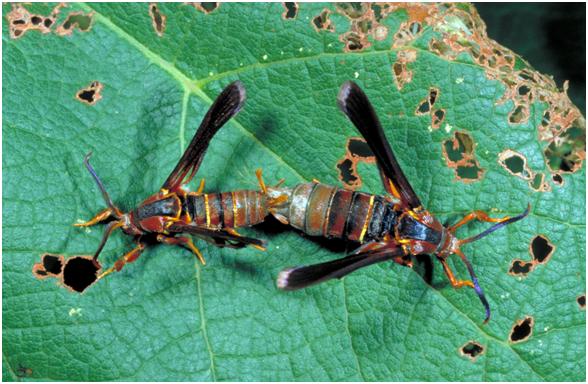The Environmental Working Group's (EWG) annual "
Dirty Dozen" list of the produce most likely to contain pesticide residues has been released. As it has in past years, the list contains several fruits, including apples (1), strawberries (3), peaches (4), imported nectarines (6), imported grapes (7), and blueberries (10).
The Dirty Dozen list often receives
significant media attention, and most balanced articles typically point out that pesticide residues measured and regulated by the
Environmental Protection Agency and that fruits and vegetables are important part of our diet which should not be eliminated or reduced because of pesticide concerns.
Pesticides, as their name makes clear, are used to manage (kill) crop pests, but the meaning of lists like the Dirty Dozen in the context of pest management is rarely, if ever, discussed. To understand what the Dirty Dozen might mean for integrated pest management (IPM), it's important to understand what is meant by the pesticide use and pesticide residues.
Methods for measuring pesticides
The EWG used several factors when considering pesticide usage on crops. These included the percentage of samples testing positive for any pesticide residue, the percentage of samples with more than one pesticide residue, the average number & quantity (ppm) of pesticide residues, and the maximum & total number of pesticides found in samples. Data compared were from routine
United States Department of Agriculture (USDA) testing. Residues measured are of materials registered for use on the crops, and residues of registered materials are regulated by EPA. In other words, legally allowable residues of pesticides registered and legally used on crops were measured, and these legally allowable residues have been determined by EPA to be safe.
The Dirty Dozen & IPM
While the number of pesticide residues present can certainly be an indication of heavy pesticide usage, it may also be related to a sound pesticide rotation as part of a resistance management program. It is actually worse for the environment and the farmer to use a single pesticide against all pests for two reasons:
1. Pesticides that are effective against many pests are called "broad spectrum" and are also often toxic to non target and beneficial organisms. In other words, broad spectrum materials can kill things we don't want to kill. When narrower spectrum or species specific pesticides are available, these are a better choice.
2. A single pesticide used against a species that has more than one generations per growing season (like
SWD)
For these reasons, samples with more than one pesticide residue or relatively large numbers of different pesticides present are not necessarily troubling in the context of IPM.
Where I think IPM practitioners can learn from lists like the Dirty Dozen, however, is with respect to residue quantity and maximum residue levels. It is important to stress, again, that the materials detected are legally registered and used on fruits and vegetables. Produce with detectable levels of unregistered pesticides would not be allowed to be sold.
However, my goal as an applied entomologist is to develop integrated insect management strategies, of which pesticides may one, but not the only, tool. Fruit crops where relatively high levels of pesticides are detected suggest that few non pesticide options exist. This is a challenge and an opportunity for applied research. This is a call to arms to develop management tools which reduce our reliance on pesticides in strawberries, blueberries, and the rest of the Dirty Dozen. Just as consumers should not be afraid to eat the produce on this list, growers and scientists should not be afraid of the information it contains and should take this as an opportunity to improve our production systems.
Sound applied research takes time, but one project already underway was highlighted in South Carolina at an agent-training tour I participated in. Spearheaded by
Dr. Natalia Peres, University of Florida, with cooperators in the Carolinas, this project uses weather data to predict when strawberry fungal disease can infect fruit and only recommends pesticide applications if conditions are right for infection. In test locations, this has resulted in a significant reduction in pesticide usage when compared to a standard, weekly spray schedule. This type of pesticide reduction is exciting but is the result of years of previous research. It is important that the need for meaningful, applied research is not lost in discussions of food choice and food security.
It is important to be conscious in our food choices, but it is just as important to be conscious of the infrastructure needed to support the ability to choose. The importance of applied agricultural research has not diminished in the current era of budget tightening, but it is being pushed to the edge of priorities. This decreased support directly limits our ability to respond to public concerns like the Dirty Dozen and its list cousins.





































